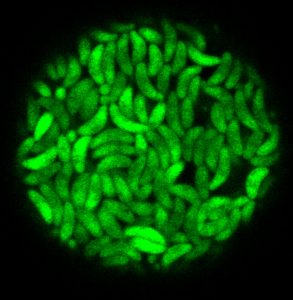
The cat parasite Toxoplasma gondii is known to cause infected rodents to lose their fear of feline predators, which makes the mice much easier prey to catch. However, a newly reported study suggests that rather than exhibiting a specific loss of feline-specific fear, infected rodents actually show a much more comprehensive decrease in general anxiety and reduced aversion to a wide range of threats. The results challenge the commonly held notion that the parasite’s manipulation of host behavior specifically targets neural circuits responding to feline predators.
So, do the new findings have implications for the 30% or so of the human population that is estimated to be infected with T gondii? Prior studies have linked latent toxoplasmosis with the risk for some psychiatric disorders, but humans generally exhibit fewer symptoms than rodents following T. gondii infection, and the University of Geneva-led team urges caution when making broad assumptions as a result of their latest work in mice. “We hope that people understand that they will not get the ‘crazy cat lady syndrome’ if they are infected with T. gondii,” said Dominique Soldati-Favre, PhD, group leader at the University of Geneva. Nevertheless, added Ivan Rodriguez, PhD, professor, University of Geneva, “For 20 years, T. gondii has served as a textbook example for a parasitic adaptive manipulation, mainly because of the specificity of this manipulation. We now show that the behavioral alteration does not only affect fear of feline predators but that major changes occur in the brain of infected mice, affecting various behaviors and neural function in general.”
Soldati-Favre and Rodrigez are co-senior authors of the team’s study in Cell Reports, which is titled, “Neuroinflammation-Associated Aspecific Manipulation of Mouse Predator Fear by Toxoplasms gondii.”
T. gondii is a single-celled parasite that infects most species of warm-blooded animals, including humans, causing the disease toxoplasmosis. Toxoplasma can persist for long periods of time in the body, possibly even for a lifetime. More than 40 million people in the United States may carry the parasite. The T. gondii life cycle involves two hosts. Cats are infected when they eat tissue cysts carried by infected prey. In the felid intestine, the parasite undergoes gametogenesis, and infectious oocysts resulting from sexual reproduction are released in the cat feces. The oocysts are then taken up by any of a wide range of warm-blooded mammals, which act as intermediate hosts. In these intermediate hosts, the parasite develops into fast-replicating tachyzoites that spread throughout different organs, and differentiate into slow-growing bradyzoites within tissue cysts. These can live for a long time in neurons and skeletal muscle cells.
While only very few T. gondii-infected humans display symptoms, toxoplasmosis is considered to be a leading cause of death attributed to foodborne illness in the United States. Infection during pregnancy can result in fetal death, and toxoplasmosis is also a threat in individuals with compromised immune systems. And with a third of the world’s human population thought to be infected by the parasite, latent toxoplasmosis is a risk factor for several mental illnesses, including schizophrenia, Parkinson’s disease, and bipolar disorder, as well as for traffic accidents and suicide attempts.
Prey animals don’t have to learn how to react when faced with a predator, even for the first time, the authors pointed out. Innate freeze or flee behaviors kick in, and these instinctive predator avoidance reactions represents a survival strategy that, if altered, could affect the prey’s chance of survival. Past studies have shown that T. gondii causes a phenomenon known as ‘fatal attraction’ in infected rodents. This manifests as a loss of fear of and aversion to cat odors, which is believed to then make the mice easier to catch and eat, and so increasing parasite spread. Prior studies have shown that this reduction in feline fear in T. gondii-infected rodents appears to the result of changes the neuronal level, the team noted. “The decreased aversion to felids is seemingly not resulting from an impairment of olfactory faculties but appears to be a consequence of complex neuronal and physiological mechanisms altering the perception of the host when facing a predation risk,” the authors wrote. And while “multiple neuronal changes that occur during infection, such as the alteration of neurotransmitter levels or metabolism and hormone level changes” have been implicated in the modulation of behavior, the underlying mechanisms aren’t understood. “… many contradictory or inconsistent results have been reported relative to the effects of T. gondii infection on rodent behavior, making conclusions on the underlying mechanisms challenging.”
“It was particularly intriguing for us to understand how the parasite achieves a specific alteration of the neural circuits involved in the fear responses toward feline predators, something that has never been elucidated,” said Soldati-Favre. “Our initial idea was to investigate the molecular mechanisms behind this behavioral manipulation. But considering that many contradictory or inconsistent results have been reported regarding the effects of T. gondii infection on rodent behavior, we later decided to reappraise the dogma.”
For their newly reported study, the researchers carried out a large battery of behavioral tests on T. gondii-infected mice. The results showed that T. gondii infection does not selectively reduce fear of feline predators. Rather, mice infected with the parasite for 5–10 weeks spent more time in the infected mice boldly walked over the rat.
“T. gondii-infected mice exhibit a general loss of predator avoidance behavior, which is not specific to felid predators, the definitive host of the parasite,” the investigators stated. “Taken together, these findings refute the myth of a selective loss of cat fear in T. gondii-infected mice and point toward widespread immune-related alterations of behaviors.”

The researchers used light-sheet microscopy to accurately map the brain-wide distribution, size, and number of cysts in the brains of mice, at unprecedented resolution in 3D. Analysis of the whole brains of animals 10–12 weeks after infection showed that the density of parasite-filled tissue cysts was especially high in the cerebral cortex and in particular in those brain regions involved in processing visual information. However, cyst localization was widespread, and cyst number and distribution varied between mice, suggesting a random infection and dissemination process.
Importantly, the analyses did show that the severity of T. gondii-induced behavioral changes was associated with cyst load and neuroinflammation. “Cyst load, markers of inflammation, and transcriptional changes occurring in the host brain indicated that the severity of the behavioral alterations is associated with neuroinflammation,” the scientists stated. “Moreover, and importantly, both gene expression levels and concentration of plasmatic pro-inflammatory cytokines vary according to the cyst load, and all three parameters correlate with the severity of a behavioral alteration characteristic of T. gondii infection … Given the broad range of behavioral phenotypes that we and others observed in infected mice (such as alterations of motor and learning performance, memory, sociability, dominance, mate choice, anxiety, locomotor activity, and exploration), it is conceivable that these reflect side effects of neuroinflammation, rather than result from a targeted modification of a specific neural circuit.”
“Taken together, the findings point toward behavioral manipulation mediated by neuronal inflammation rather than direct interference of the parasite itself with specific neuronal populations,” Rodriguez commented. “It is not a simple on/off system. In the future, the level of chronic infection should therefore always be taken into account when studying effects of T. gondii on its host.”
Even though the behavioral effects induced by T. gondii infection are not specific, they are still adaptive for the parasite. Infected rodents are supposedly easier to catch by predators, which facilitates parasite spreading. On the other hand, research on the protozoan parasite Eimeria vermiformis, which also reduces predator fear in infected mice, suggests that the behavioral effects of infection are not adaptive in all cases.
Moving forward, the researchers plan to examine in more detail how neuroinflammation can alter behavioral traits such as anxiety, sociability, or curiosity. They suggest that caution should be exercised when considering the implications of their rodent study results to human T. gondii infection. “Although it seems that subtle behavioral changes may occur in humans, the inflammation in the human brain might never reach the same level as laboratory infected mice, said Soldati-Favre.” Even so, the scientists stated, “Although we should be very cautious in making direct translations of our findings based on mouse behavior to human behaviors and psychology, it is clear that inflammatory responses in the CNS are known to contribute to neuronal damage associated with neurodegenerative diseases and may mediate Alzheimer’s disease pathogenesis. Thus, the potential effect of T. gondii infection on neuronal function in humans should not be underestimated.”


